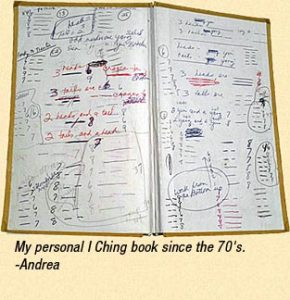Working with the I Ching
There are pivotal times in our lives when we are faced with challenging decisions, relationship questions, work dilemmas. The I Ching, the ancient Chinese oracle, can help us reveal underlying issues that relate to our concerns. It can also strengthen our sense of direction, steer us onto an inspiring path — or simply confirm what we had realized all along.

Today, there are many versions of the I Ching. Since the early 70’s, I have used the Wilhelm-Baynes translation, entitled: The I Ching or Book of Changes, published by Princeton University Press. As you can see, I have really used it.
Most of the editions include instructions on how to cast the oracle. For readers who may not have not encountered the I Ching before, here is a brief description of how to “throw” the I Ching using the simplest method: three coins.
Formulating Your Question
When you formulate your question, I recommend that you create a sacred space. Clear off a tabletop or a flat surface. You want the space to be clean, without any clutter. You may even want to light some candles and sage to purify the air. Focus your attention on your question, and then move gently into a state of receptivity. I usually start my question with the words: Would [blank] be for my highest good?
Tossing the Coins
As described in Pushing Upward, yarrow stalks were used for centuries to cast the oracle — a very complex process. Today, most people use coins. I use either three dimes, three nickels, or three pennies. Ming Dynasty coins can also be used and may be found in local Asian stores. Whatever you pick, it’s best if you use three of the same type of coin.
Stay focused on your subject or question when casting. Hold the three coins loosely in your hands, shake them briefly but mindfully, and then toss them six times.
The Hexagrams
The I Ching system consists of sixty-four six-line patterns, or hexagrams, each of which is composed of a stacked pair of three-line trigrams. The individual lines are either solid (yang) or broken (yin).
The character of each line is determined by assigning a numerical value. “Heads” are counted as 3, “tails” are counted as 2. With three coins, there are four possible “throws”:
Two tails and a head = 7 (yang, an unbroken line)
Three heads = 9 (“moving” yang)
Two heads and a tail = 8 (yin, a broken line)
Three tails = 6 (“moving” yin)
As you cast the coins, write down the numerical value of each throw and draw a corresponding line: a solid line for yang, a broken line for yin. You will want to build your six-line hexagram from the bottom up.
Line 6 ▬▬▬ = 9
Line 5 ▬▬▬ = 7
Line 4 ▬▬▬ = 7
Line 3 ▬ ▬ = 8
Line 2 ▬ ▬ = 8
Line 1 ▬ ▬ = 6
The hexagram that you come up with is considered the “present hexagram”; it represents energies that are in play in your current situation or with regard to your query. It is a response to your question. Any version of the I Ching you choose will include a chart in which you can look up the hexagram you have thrown. Some oracles will include a judgment, an image corresponding to the hexagram as a whole and commentaries. Plenty of food for contemplation!
Moving Lines
If you happen to throw a 6 or a 9, these are referred to as moving lines, or changing lines. They are called moving because they will change into their opposites. For instance, the 6 in line 1 above, known as “6 in the first place,” will become a solid line, and the 9 in line 6 above, known as “9 at the top,” will become a broken line. When lines “move,” or transform this way, they generate a new hexagram. Look up this hexagram as well.
Line 6 ▬ ▬ = 6
Line 5 ▬▬▬ = 7
Line 4 ▬▬▬ = 7
Line 3 ▬ ▬ = 8
Line 2 ▬ ▬ = 8
Line 1 ▬▬▬ = 9
The moving lines can be very important; they provide additional perspectives, pointing to aspects of your question or the situation you may not have taken into consideration, or forces coming into play that you may not yet be aware of. When moving lines appear, they may also indicate the presence of a great deal of power or potential energy in the matter that concerns you. When you look up the description of the hexagram, you can read commentaries on the moving lines as well as the depiction of the hexagram as a whole and the trigrams which compose it.

If you would like a private I Ching reading with Andrea,
E-mail Andrea at: andrea@pushingupward.com
![]()
“Andrea Adler doesn’t just read the I Ching — she reads your very soul! The time we shared during the reading has already uplifted, enlightened, and empowered me immeasurably. I endorse her work with all my heart.”
— Joseph Ross, Astrologer
